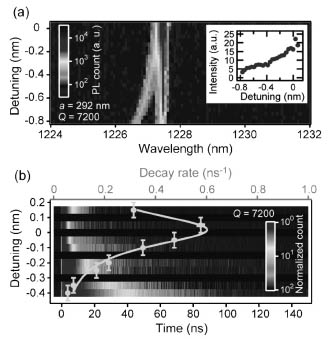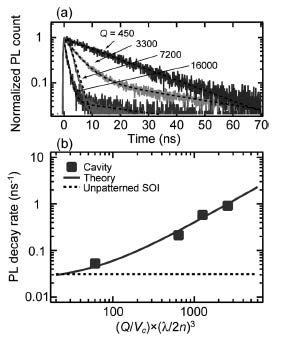1Nanophotonics Center, 2Optical Science Laboratory
Impurities binding an exciton in Si show intense emission
without phonon emission and attract a lot of attention as quantum bits
(qubits) manipulated by light because of their long-lived spins. However,
the light-impurity interaction is inefficient due to nonradiative processes
including the Auger process. In this study, we focused on the combination
of copper isoelectronic centers (Cu-IECs) and photonic crystal (PhC) nanocavities.
The IEC originates from a bound exciton of deep impurities. Since the IEC
is free from the Auger process, its emission quantum efficiency (QE) is
high [1]. In addition, the high-Q nanocavity accelerates spontaneous emission from the Cu-IECs, which is
known as the Purcell effect, and enhances the light-impurity interaction.
We have developed a novel method for doping the Cu-IECs
to a SOI wafer. The Si PhC nanocavities were fabricated on the Cu-doped
SOI wafer. Figure 1 shows photoluminescence (PL) spectra for the cavity
with Q = 7200 and PL decays of the Cu-IECs. At 1227.5 nm, the emission peak of the Cu-IECs is found. The blue-side peak originates from the cavity resonance. When the cavity resonance approaches to the Cu-IEC line, the PL intensity and the decay rate of the Cu-IECs increase and take maximum values at zero detuning. Figure 2 shows PL decays and decay rates of the Cu-IECs in resonant cavities as a function of the Q/V value of the cavity. It is found that the decay rate is almost proportional
to Q/V. This result proves the Purcell effect on the Cu-IECs because the theoretical
estimation agrees well to the experimental data. In the highest-Q cavity (Q = 16000), the PL lifetime of the Cu-IECs is 1.1 ns, which is 30 times shorter than that in an unpatterned SOI sample. Since this PL lifetime is sufficiently smaller than the nonradiative lifetime around 40 ns, the QE may close to unity.
These results enable to develop novel fast and energy-efficient
Si light emitting devices and quantum optical devices based on impurity
qubits in Si.
[1] S. P. Watkins et al., Solid State Commun. 43 (1982) 687.
 |
 |
|||||
|
|